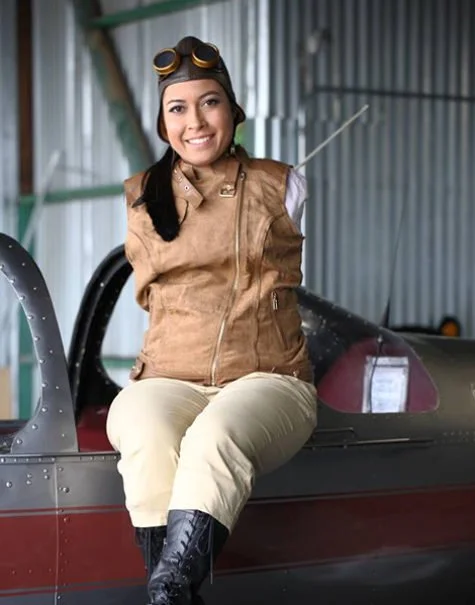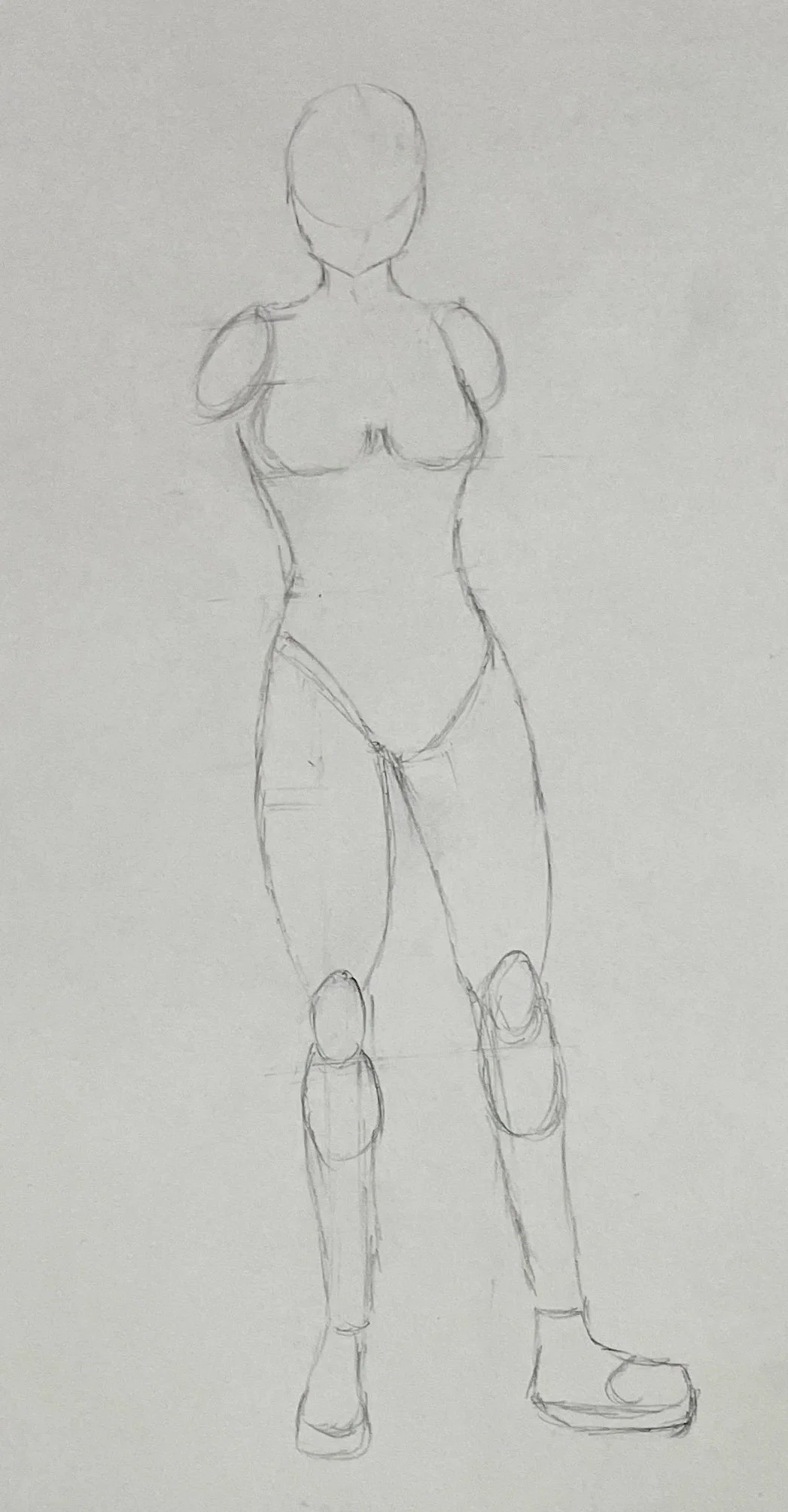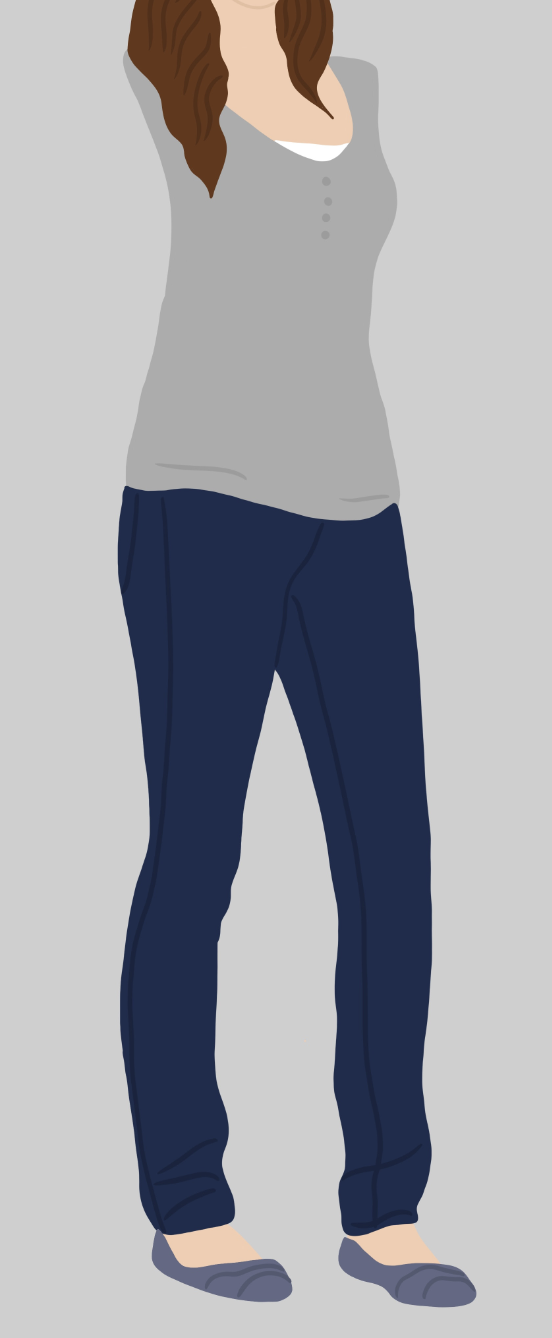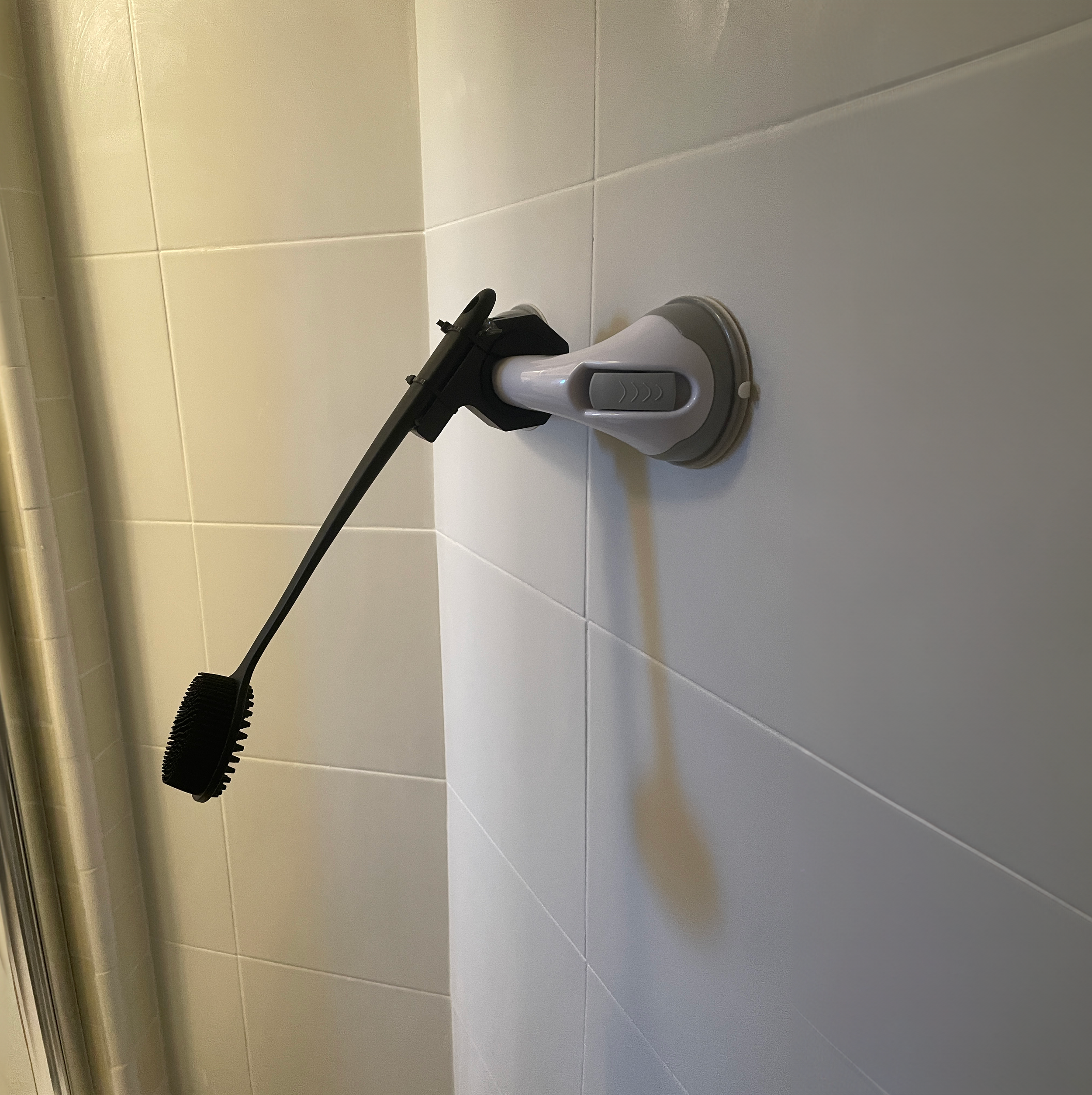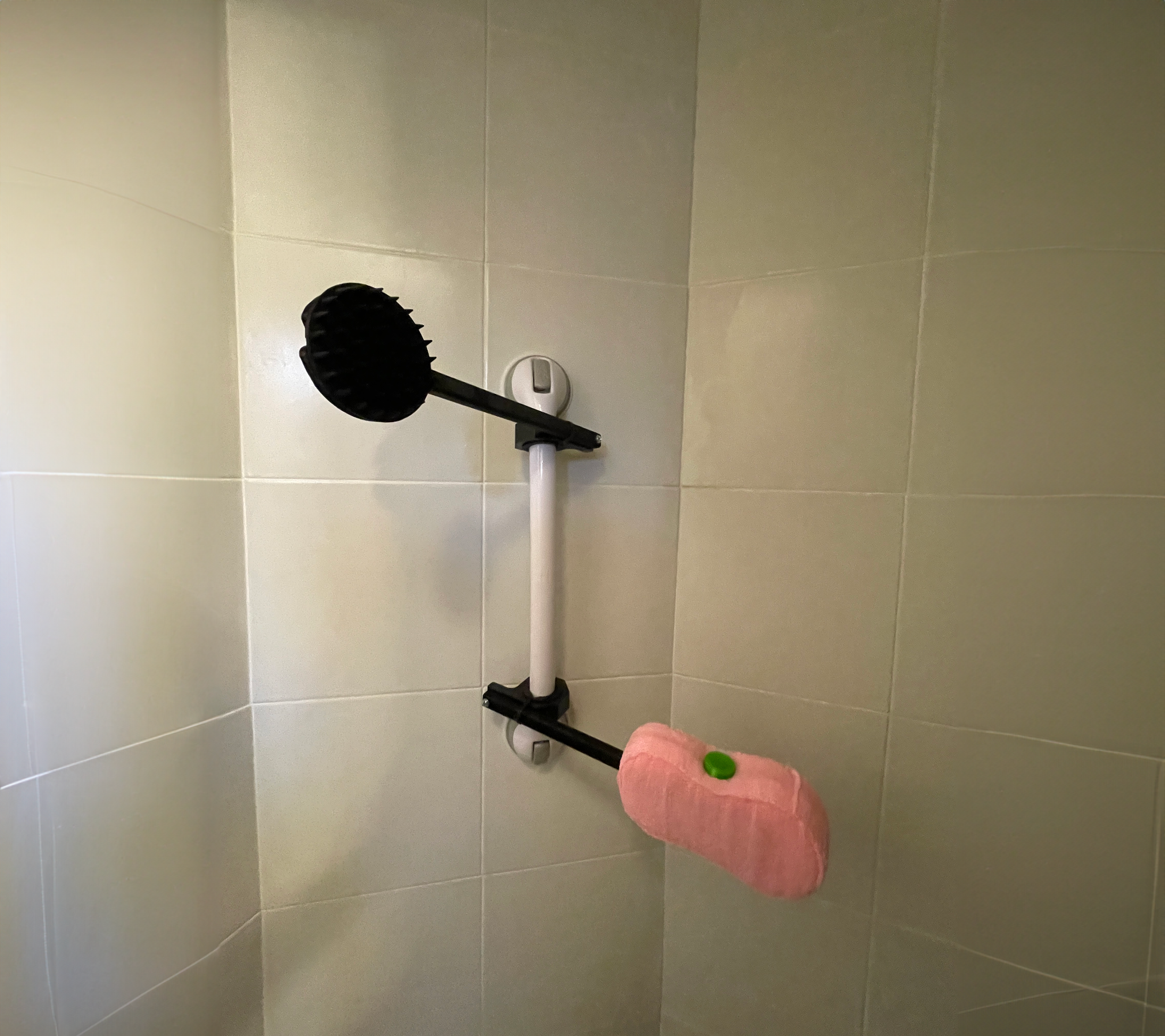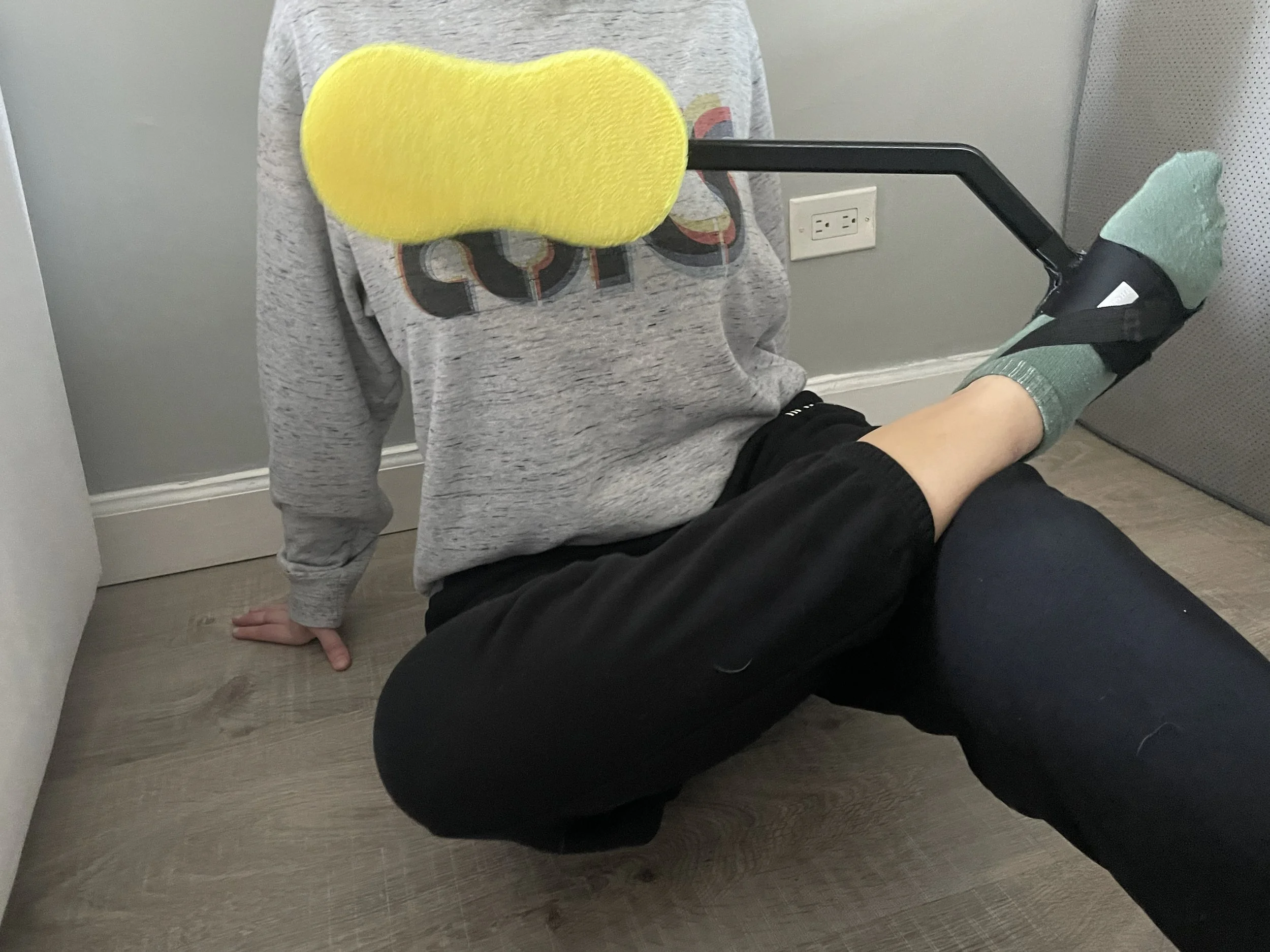ACCESS-I-SCRUB
Exploring Hands-Free Approaches to Body and Hair Washing
for Individuals with Bilateral Upper Extremity Limb Loss
Aneesah Saeed - IDM Masters Thesis Spring 2024
in collaboration with Jessica Cox
ACCESS-I-SCRUB is a showering product designed for individuals with bilateral upper extremity limb loss, enabling hair scrubbing and body washing without upper limb use. In collaboration with Jessica Cox, a motivational speaker and Guinness World Record holder with bilateral upper extremity limb loss, this project aims to comprehend the challenges faced by armless individuals in shower environments.
Through interviews, research, prototyping, and testing, ACCESS I-SCRUB showcases the evolution of custom-built prototypes designed by modifying and combining existing products and 3D printing new ones to enhance accessibility in body scrubbing and hair washing. The project's mission is to raise awareness and instigate change in assistive technology and product design, making body scrubbing and hair washing more inclusive and accessible.
ABOUT
The purpose of this study is to understand the challenges and experiences of individuals with bilateral upper extremity limb loss when interacting with technology. Bilateral upper extremity limb loss encompasses the loss or absence of any part of the upper limb, from the shoulder down to the fingers. For the scope of this project, we had to constitute what we mean by a technology. The definition we came up with is that a technology is any design or assistive modification whether it be entirely original or an addition to existing product to make it more usable for individuals with upper extremity limb loss.
WHAT IS BILATERAL UPPER EXTREMITY LIMB LOSS?
The project’s purpose is to understand the challenges and experiences of individuals with bilateral upper extremity limb loss when interacting with technology. Bilateral upper extremity limb loss encompasses the loss or absence of any part of the upper limb, from the shoulder down to the fingers. For the scope of this project, we had to constitute what we mean by technology. The definition we came up with is that a technology is any design or assistive modification whether it be entirely original or an addition to an existing product to make it more usable for individuals with upper extremity limb loss.
In the client’s case, the method of washing the hair is to sit on the ground where she has a customized cubby setup of shampoo, conditioner, and other shower products all in pump bottles. She uses one foot to pump the bottle and the other foot to catch the product. She then quickly reaches the foot with the product to her body where she then begins to lather in the product or top of her head to wash her hair. She mentioned that often product goes to waste as it falls from her foot. Another pain point for hair washing is that it is difficult for her to reach past her ears. As for body scrubbing, she currently uses the hands-free back scrubber that is mounted onto the wall. The issue is that this scrubber is flat against the wall causing her to be in close contact with the cold shower tile. This is not the most comfortable as her back is brushed up against the wall and the only body part she can effectively scrub is her back. She can turn around to scrub her chest but that causes her to stand in an awkward position.
THE PROBLEM
RESEARCH QUESTIONS
-
What difficulties do individuals with upper extremity limb loss face with the standard shower products for body scrubbing and hair washing?
-
What do individuals with bilateral upper extremity limb loss currently use when showering to wash their hair and body?
-
How do individuals with upper extremity limb loss perceive the usability and effectiveness of current hands-free back scrubber designs in meeting their hygiene needs?
-
What modifications would be useful to improve the accessibility and usability of shower products and tools for hair washing and body scrubbing?
RESEARCH & INTERVIEW FINDINGS
-
4 in 10,000 babies in the US are born with upper limb reductions.
-
Nearly 2 million people live with limb loss in the US.
-
Current shower designs often lack features catering to individuals with disabilities
-
Armless individuals may prefer to not use prostethics.
-
Existing shower products do not address the diverse accessibility needs of individuals.
-
3D printing allows for customizing existing products to better fit individual needs.
COMPETITIVE ANALYSIS
After identifying the problem, I did a competitive analysis to understand what body scrubbing products currently exist and identified their strengths and weaknesses. This process confirmed that there are no products currently on the market that solves Jessica’s pain points when showering. The “Hands Free Back Scrubber” on the far right is the product that she currently uses to scrub. The issue with this product is that it is mounted on the wall and can only effectively scrub her back area. It’s close proximity to the wall causes her to have her back against the cold shower tile which makes it uncomfortable. She is able to scrub her upper chest as well but that causes her to be in an awkward position with her face up close against the wall. For this reason, we knew that the product we’d design would have to be extruded outwards at an angle to ensure she is not having to scrub up against a wall.
DESIGN & RESEARCH METHODS
The first research method I used was participatory design and research. I chose this method because I worked with Jessica through every step and design decision as I would not have known about the challenges people with bilateral upper extremity limb loss face without hearing about her pain points and experience. I also used the Occupational Therapy task analysis framework which is the process used by OT’s to understand the dynamic relationship between a client, a chosen task, and certain contexts.
FUSION 360 DESIGNS
Evolution of Prototypes
Prototype 1
Materials:
12-inch Shower Bar, Aluminum Clamp, Zip tie, Silicone body brush
I created the first prototype using a shower bar and a silicone body scrubber attached with a clamp and zip ties. This proof of concept helped validate if having the bar at an angle would be useful. The feedback I received at this stage was that I was headed in the right direction with angulating the scrubber to extend outward. This idea would likely be easier to scrub different parts of the body and cover more surface area. However, the silicone scrubber head was a bit small.
Prototype 2
Materials:
12-inch Shower Bar, Adjustable Bike Clamp, Zip tie, Silicone body brush, Braided Loofah, Automatic Dispenser, Tubing
The method that I pursued was to use an automatic dispenser and attach it to the shower bar. I purchased an automatic dispenser that is currently motion-activated and dispenses the solution placed inside typically after receiving motion from a hand. The feedback received from prototype 2 was that the loofah works well, and the automated dispenser effectively releases solution throughout the loofah arm. The arm also effectively rotates up and down, but the client struggled to lock it in place for it to not move when in use.
Portable Body Scrubber
Materials:
Arthritis Foot Support Band, 3D PTEG Printed Support Band Insert and angled body scrubber arm, Sponge, Exfoliating Wash Cloth, Needle, and Thread.
Another pain point the client mentioned was her inability to effectively scrub her body when traveling. She wanted a portable version to use when she is on the go and does not have access to her home setup. Since the client has great dexterity, she can reach up to her head when in a seated position.
For this reason, we decided that having some form of cuff that wraps around her foot would potentially work for an on-the-go body scrubber. I started with an adjustable arch support band that I purchased that is commonly used for people with flat feet. The piece has a strap to wrap around the ankle and the ball of the foot. Since there is an opening meant for the support gel to be inserted. I removed the sewing to open the inside. For the extending arm, I 3D printed an arm that bends to have more of an angulation and reach the back of the body.
ACCESS-I-SCRUB Product
Materials:
24-inch Shower Bar, Aluminum Clamp, PTEG 3D Printed Arm/Sponge Frame, PTEG 3D Printed Arm/Hair Scrubber cup, TPU 3D Printed Body Wash Container, Sponge, Exfoliating Wash Cloth, Needle and Thread.
For the final product, we focused on a way to make the shower bar more modular to integrate a hands-free hair-washing component in addition to the body scrubber arm. The first piece is the hair scrubber holder was created by 3D printing a hair scrubber cup with two bumps inside the holder to keep it from coming off when rubbing your scalp against it. It was then attached to the 3D printed arm and clamped onto the shower bar angled to the side at the appropriate height of the client where the client can move her neck back and forth against the hair scrubber to lather her two-in-one shampoo/conditioner into the hair.
The second piece attached to the shower bar is the body washing component which entails the 3D printed arm inserted inside a TPU body wash canister that has 12 holes on each side and is angled 35 degrees downward. The body wash canister was designed as a low-tech option to excrete body wash when pressing against a sponge.


